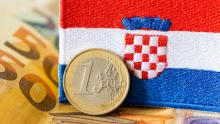1 euro cent coin
Coin Circulation in Bulgaria Hits Record High Despite Devaluation
Bulgarians continue to embrace the use of coins, as evidenced by the latest figures from the Bulgarian National Bank (BNB). The total number of coins in circulation reached 3,315,164,574 units by the end of September, showing growth both compared to August and on an annual basis.
Bulgaria Completes Approval Process for Euro Coin Designs (PHOTOS)
The Bulgarian National Bank (BNB) has marked a significant milestone in the nation's journey towards full integration into the Eurozone by finalizing the approval of the design for Bulgarian euro coins.
This crucial step underscores Bulgaria's readiness to adopt the euro as its official currency and represents a pivotal moment in the country's preparations for Eurozone membership.
Euro not legal tender in so-called Kosovo - ECB, EC
FRANKFURT - The euro is not a legal tender in the so-called Kosovo as Pristina unilaterally adopted it as the de facto currency in 2002, the European Central Bank (ECB) website says.
It notes that Montenegro, which is also not an EU member, did the same in 2002.
Entry Into The Eurozone Has Not Significantly Affected Price Increases In Croatia
Although the residents of Zagreb complain that everything has become more expensive and many explain the increase in prices with the switch to the European currency, the Croatian National Bank said that the entry into the eurozone did not significantly affect the rise in prices, writes the Belgrade newspaper "Politika", quoted by BTA.
Mixed Sentiments: Euro's High Approval Amid Croatian Skepticism"
The euro enjoys robust support across the Eurozone, with approval ratings averaging 79%, although opinions vary significantly across member states. According to a recent survey conducted by Ipsos European Public Affairs on behalf of the European Commission, diverse sentiments towards the single currency emerged, especially in Croatia, where skepticism persists.
Driver tries to pay fine in 15,500 coins
A routine fine payment at the Limassol Court on Tuesday took an unexpected and unconventional turn, leaving court officials and onlookers shaking their heads in disbelief.
- Read more about Driver tries to pay fine in 15,500 coins
- Log in to post comments
Here is what will be Depicted on the Bulgarian Euro Coins
"The Governing Council of the Bulgarian National Bank has united around the idea of reproducing the design of the current exchange coins, which will ensure continuity in the monetary signs used and will facilitate the recognition of the new currency by Bulgarian citizens, namely: the Madara Rider - on the small coins; St. John of Rila - on the 1 euro coin; and Paisius of Hilendar - on the 2
In Croatia the Prices are already Written in Euros
As of today, all prices in Croatia must be displayed in two currencies - local kunas and euros. This is a preparatory period, from the New Year the national currency will not be used. In the months until the end of the year, Croatians should get used to entering the Eurozone and, as far as possible, fraud and price abuse should be avoided, the government explains.
- Read more about In Croatia the Prices are already Written in Euros
- Log in to post comments
North Macedonia’s Faith in EU Influence Plummeting, Survey Shows
Perceptions of the EU as North Macedonia's biggest ally fell sharply from 43.2 per cent in 2019 to 13.1 per cent in 2021, the compared results of two surveys published by the Skopje-based think tank, Institute for Democracy - Societas Civilis, show.
Exhibition on Slovenia’s first currency opens in central bank
Ljubljana – An exhibition on Slovenia’s first currency, the tolar, was launched in Ljubljana on Tuesday as one of the events marking the 30th anniversary of the central bank. Visitors will be able to learn about the process of the planning and design of the currency, and see original portraits of figures featured on tolar banknotes.










